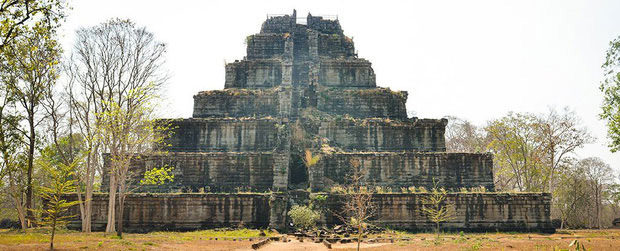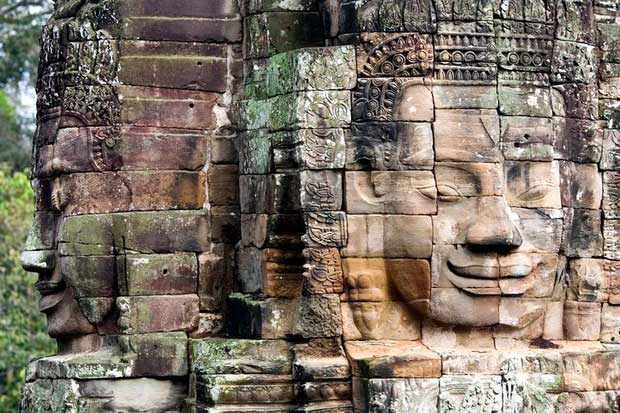Why was the ancient Khmer Empire forced to move the capital only to collapse?
The symbol of the Khmer empire is the magnificent capital of Angkor, a legend of Southeast Asia. But in fact, Angkor was not always the capital of this empire. Before that, the capital of the empire was Koh Ker, but in just 16 years from 928 to 944 it collapsed, forcing them to relocate to the legendary Ankor.

The symbol of the Khmer empire is the magnificent capital of Angkor.
The problem is that no one knows why the story happened. But now it's different. According to a recent study using underground radar scanning technology, archaeologists have finally revealed the cause of the collapse of the once Khmer capital Koh Ker: it may be because there is no one. large enough underground reservoir.
Specifically, experts from Flinders University (Australia) have found underground structures beneath the capital Koh Ker, including water pipes extending for kilometers from the Stun Rongea River. Based on calculations, the reservoir here does not seem to have enough capacity, leading to flooding that occurs very often.
It was really bad news for the then-reigning King Jayavarman IV. He was forced to bring the empire back to Angkor, which was also the capital of the empire before moving to Koh Ker. In Angkor, the water line is well designed and works without problems.
"At this time, focusing on civil projects such as building temples, urban rehabilitation and developing water systems was a central priority for Khmer kings," said Ian Moffat, an archaeologist at Flinders University. shall.

The lake in Koh Ker does not have enough capacity, leading to frequent flooding.
King Jayavarman IV, too, did all he could to have a developed water system for Koh Ker. In fact, the water management system here is also the largest in the empire's history, although it is not really efficient. It is estimated that at least 10,000 people were involved in its construction.
Unfortunately, based on surveys, it seems that the system showed instability during the first rainy season.
It is known that water management is an important issue for an agricultural empire like the Khmer, due to the monsoon weather and water supply that is difficult to predict during the year.
"It is not too difficult to understand that the collapse of the huge and ambitious water system at Koh Ker has reduced the reputation of this place, thereby causing them to decide to move the capital to Angkor" - Moffat shared shall.
Moving the capital to Angkor was a reasonable move. At that time, this place was already home to more than half a million people, and the important thing is that the water system worked a lot better than Koh Ker. Even so, the later capital Angkor could not maintain the ability to conduct water. Experts say the reason lies in the natural process of climate change, which prolongs the cycle of floods and droughts and ultimately causes the collapse of the empire.

Structures discovered beneath the capital Koh Ker.
At the present time, historians still do not know too much about Koh Ker. Just know that it is located on a gentle hillside, about 90km northeast of Angkor. However, with this study, the secrets of the Khmer empire are gradually being revealed. Earlier this past October, another buried city of the empire was discovered after decades of searching.
The study was published in the journal Geoarchaeology.
The mysterious tower complex buried beneath the temple of Angkor Wat Rampant urbanism may have destroyed Angkor Wat.
- The real reason why the ancient Khmer Empire was forced to move the capital, only to make a historical legend
- How did the Khmer Empire perish?
- Discovered the unexpected cause of the collapse of the ancient Roman empire
- Cambodia's ancient capital declined due to drought
- Fraternity is similar to the collapse of the Inca empire
- Legend of the greatest king of the Khmer empire
- Discover the world's largest empire in Cambodia
- The mystery of the disappearance of ancient civilizations
- Behind the fall of the Maya empire
- The 'ghost' in ancient pine reveals the mysterious age of 3,600-year-old empire
- Discover the mysterious old city in the jungle of Cambodia
- Discovered the ruins of the capital of the Mongol Empire
 Discovered an ancient centipede fossil 99 million years old
Discovered an ancient centipede fossil 99 million years old Discovered bat-like dinosaurs in China
Discovered bat-like dinosaurs in China Discovered a 200-year-old bronze cannon of the coast
Discovered a 200-year-old bronze cannon of the coast Discover 305 million-year-old spider fossils
Discover 305 million-year-old spider fossils